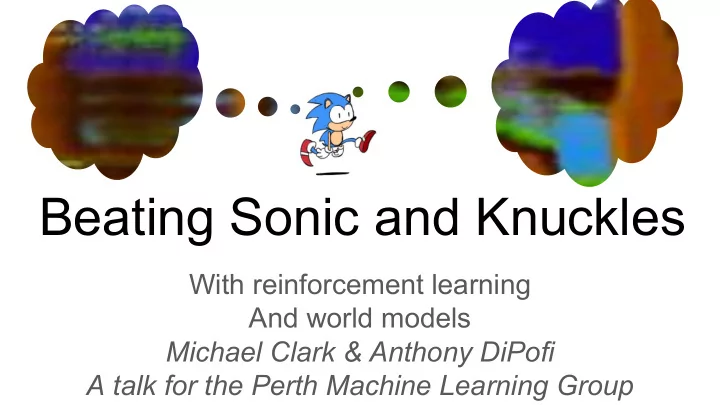

Beating Sonic and Knuckles With reinforcement learning And world models Michael Clark & Anthony DiPofi A talk for the Perth Machine Learning Group
The project - You can probably recognise the top left pane - But what do the other ones represent? - Let see…
Concepts - I’ll introduce you to these 3 concepts: 1. Reinforcement learning 2. World models 3. Mixture Density Networks
Reinforcement learning
Can be applied in industry Google’s robot arm farm
Can be applied in industry Spica.ai: Cryptocurrency trading - the black line is our RL. Does OK
But... - It needs to train for much longer than humans (not sample efficient) - It “cheats”, by doing unintended things if it can. “But you told me to get rid of the mess” - More reading: “Deep Reinforcement Learning Doesn't Work Yet” https://www.alexirpan.com/2018/02/14/rl-hard.html - If it worked really well... we wouldn’t know how to control it (yet) - I recommend Bostrom’s book Superintelligence (the audiobook) on this topic What are we missing? - Prior experience and memory - Unsupervised learning (without explicit labels) - Meta learning - ???
Cheating….
Yann Lecun’s cake
The Competition ● OpenAI has started a competition to beat Sonic the Hedgehog ● They pay staff 1M but can’t put up prize money :p ● I’m going to beat you “Deep Blockchain Quantum AI” ● https://contest.openai.com/ ● https://contest.openai.com/leaderboard
My approach: World Models ● We talked about this a few weeks ago, perhaps someone can give a summary? ○ Compress visual information ○ Predict the future ○ Act on the prediction ● Why is this interesting? ○ Reinforcement learning struggles ○ This is the “year of unsupervised learning”. ○ Like humans, it would allow artificial intelligence to learn without instruction ○ “World models” does that
World models - we will come back to this slide
World models: (V) A “visual cortex” to reduce dimensionality Z is the “latent vector”
World models: (M) MDN-RNNs ● This part predicts the future. . ● It has two components ○ Recurrent neural network: to predict the future ○ A mixture density network to output multiple probabilities Sean please explain RNN’s :p
Mixture Density Networks (M) - These output mean and standard deviations - e.g. - Means = [1, 2] - Variance = [0.5, 0.7] - But how to measure the error on a distribution? - The loss is the probability density of the true value. - Sampling: - Training: Sampled randomly - Testing: Take the mean
World models: (C) Controller
World models: (C) Controller ● In world models they used evolutionary strategies. But I use” ● “ Proximal Policy Optimization ” ● A policy gradient method ● Continuous action space ● Why? ○ Well tested, reliable, and general ○ Lots of code exists ○ Stockholm syndrome ● https://arxiv.org/abs/1707.06347 https://arxiv.org/abs/1707.06347
PPO: Key insight ● We’re at the black dot, we want to go up. ● Red line - actual performance of policy parameter theta ● Green line - unconstrained loss - a local approximation. But if you go to far away all bets are off ● The blue line is pessimistic, let just make a tiny jump to the top. That way we are always guaranteed to improve and not overshoot! (it’s a surrogate loss penalised with KL divergence, forming a lower bound) ● Expert explanation: https://youtu.be/xvRrgxcpaHY?t=17m27s ○ From “Deep RL Bootcamp” ● https://arxiv.org/abs/1707.06347
The project - You can probably recognise the top left pane - But what do the other ones represent? - Latent vectors, and decoded latent vectors
World models: Summary
Code ● Worked with Anthony DiPofi (Alabama) who I met on reddit.com/r/reinforcementlearning ○ https://github.com/goolulusaurs ● PyTorch: https://github.com/ShangtongZhang/DeepRL <3 ● ~3 Weekends ● ~$200 of compute ● ~10,000 tears later ● ~100,000 hedgehogs were virtually harmed ● It’ll release the code on https://github.com/wassname in a month
Demo: Before training
1 hour of training on first three levels
100k steps of training, ALL levels, 512 latent dims
100k steps of training, ALL levels, 512 latent dims
Final status - I haven’t had time to tweak the controller so it’s only learnt to mash buttons - Competition ends at the end of the month - There seems to be a bug with the predicted latent state when running -
More readings: - Podcasts: - http://lineardigressions.com/episodes/2018/3/11/autoencoders - http://www.thetalkingmachines.com/episodes/strong-ai-and-autoencoders - Audiobook: - Superintelligence: Paths, Dangers, Strategies - Mixture density networks tutorial - https://github.com/hardmaru/pytorch_notebooks/blob/master/mixture_density_networks.ipynb - RL Courses: - Berkeley deep rl bootcamp - David silvers course - Papers: all the papers
Some practical tips - To do joint training I needed a low learning rate and to weight them in order of dependency - The VAE took the longest to train (days), and the most data (300,000 frames). -
Recommend
More recommend